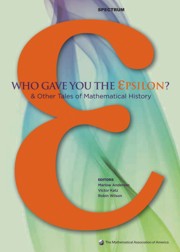Book contents
- Frontmatter
- Introduction
- Contents
- Analysis
- Geometry, Topology and Foundations
- Algebra and Number Theory
- Foreword
- Hamilton's Discovery of Quaternions
- Hamilton, Rodrigues, and the Quaternion Scandal
- Building an International Reputation: The Case of J. J. Sylvester (1814–1897)
- The Foundation Period in the History of Group Theory
- The Evolution of Group Theory: A Brief Survey
- The Search for Finite Simple Groups
- Genius and Biographers: The Fictionalization of Evariste Galois
- Hermann Grassmann and the Creation of Linear Algebra
- The Roots of Commutative Algebra in Algebraic Number Theory
- Eisenstein's Misunderstood Geometric Proof of the Quadratic Reciprocity Theorem
- Waring's Problem
- A History of the Prime Number Theorem
- A Hundred Years of Prime Numbers
- The Indian Mathematician Ramanujan
- Emmy Noether
- “ Marvelous Proof,”
- Afterword
- Surveys
- Index
- About the Editors
The Indian Mathematician Ramanujan
from Algebra and Number Theory
- Frontmatter
- Introduction
- Contents
- Analysis
- Geometry, Topology and Foundations
- Algebra and Number Theory
- Foreword
- Hamilton's Discovery of Quaternions
- Hamilton, Rodrigues, and the Quaternion Scandal
- Building an International Reputation: The Case of J. J. Sylvester (1814–1897)
- The Foundation Period in the History of Group Theory
- The Evolution of Group Theory: A Brief Survey
- The Search for Finite Simple Groups
- Genius and Biographers: The Fictionalization of Evariste Galois
- Hermann Grassmann and the Creation of Linear Algebra
- The Roots of Commutative Algebra in Algebraic Number Theory
- Eisenstein's Misunderstood Geometric Proof of the Quadratic Reciprocity Theorem
- Waring's Problem
- A History of the Prime Number Theorem
- A Hundred Years of Prime Numbers
- The Indian Mathematician Ramanujan
- Emmy Noether
- “ Marvelous Proof,”
- Afterword
- Surveys
- Index
- About the Editors
Summary
I have set myself a task in these lectures which is genuinely difficult and which, if I were determined to begin by making every excuse for failure, I might represent as almost impossible. I have to form myself, as I have never really formed before, and to try to help you to form, some sort of reasoned estimate of the most romantic figure in the recent history of mathematics; a man whose career seems full of paradoxes and contradictions, who defies almost all the canons by which we are accustomed to judge one another, and about whom all of us will probably agree in one judgment only, that he was in some sense a very great mathematician.
The difficulties in judging Ramanujan are obvious and formidable enough. Ramanujan was an Indian, and I suppose that it is always a little difficult for an Englishman and an Indian to understand one another properly. He was, at the best, a half-educated Indian; he never had the advantages, such as they are, of an orthodox Indian training; he never was able to pass the First Arts Examination of an Indian university, and never could rise even to be a “Failed B.A.”He worked, for most of his life, in practically complete ignorance of modern European mathematics, and died when he was a little over 30 and when his mathematical education had in some ways hardly begun. He published abundantly—his published papers make a volume of nearly 400 pages—but he also left a mass of unpublished work which had never been analysed properly until the last few years.
- Type
- Chapter
- Information
- Who Gave You the Epsilon?And Other Tales of Mathematical History, pp. 337 - 348Publisher: Mathematical Association of AmericaPrint publication year: 2009

